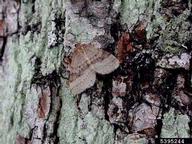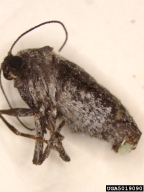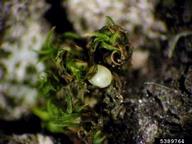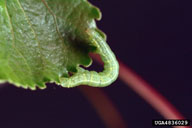Bruce spanworm
Operophtera bruceata (Hulst) (Lepidoptera: Geometridae)
Orientation to pest
Bruce spanworm, Operophtera bruceata (Hulst), is a native geometrid moth in North America that closely resembles winter moth (Operophtera brumata [L.]). It is found from coast to coast in Canada and from New England to the Lake States in the United States. Bruce spanworm is a defoliator and a generalist feeder, attacking a variety of hardwoods. Bruce spanworm overwinters as eggs, which hatch early in spring. Larvae either feed openly or in the shelter of leaves that are loosely rolled and webbed together. When mature, larvae drop to the ground, where they pupate. Adults emerge in fall. Females, which are wingless, climb trees to lay eggs in bark crevices or under loose bark. Defoliating outbreaks have been reported.
Hosts commonly attacked
This species is a generalist feeder that attacks are variety of hardwoods, but especially sugar maple (Acer saccharum Marshall), trembling aspen (Populus tremuloides Michx.), willow (Salix), and American beech (Fagus grandifolia Ehrh.), among others.
Distribution
This geometrid is found from coast to coast in Canada and from New England to the Lake states in the United States.
Images of bruce spanworm
 Ronald S. Kelley, Vermont Department of Forests, Parks and Recreation, Bugwood.org 768x512 / 1536x1024 Ronald S. Kelley, Vermont Department of Forests, Parks and Recreation, Bugwood.org 768x512 / 1536x1024 Pennsylvania Department of Conservation and Natural Resources - Forestry Archive, Bugwood.org 768x512 Pennsylvania Department of Conservation and Natural Resources - Forestry Archive, Bugwood.org 768x512 |
|||
| Figure 1. Adults of bruce spanworm, Operophtera bruceata; male (left) and wingless female (right) | Figure 2. Egg of bruce spanworm | Figure 3. Larvae of bruce spanworm | |
Important biological control agents related to this pest species
The natural enemies of this species are less well known than are those of the closely related winter moth.
Web links for information on bruce spanworm
Articles
- Elkinton, J. S., G. H. Boettner, M. Sremac, R. Gwiazdowski, R. R. Hunkins, J. Callahan, S. B. Scheufele, C. P. Donahue, A. H. Porter, A. Khrimian, B. M. Whited, and N. K. Campbell. 2010. Survey for winter moth (Lepidoptera: Geometridae) in northeastern North America with pheromone-baited traps and hybridization with the native Bruce spanworm (Lepidoptera: Geometridae). Annals of the Entomological Society of America 103: 135-145.





